The survey suggests the U.S. designer resource is aging at an
excellerated rate, so we need to ask, “Where is the next generation of
PCB designers?”
We have just completed our annual salary survey. The results from a
number of perspectives were very predictable. Our audience and,
therefore the people who responded, are on average two years older than
they were last year indicating that there has been no significant young
engineers joining the ranks.
In 2007, the designers who participated
made on average over $10,000 more than their 2006 counterparts. This
jump can be attributed to a slightly different mix in the respondents
versus 2006. There were a higher number of more experienced and older
designers responding this year versus last year as our average age
increased by two versus the anticipated one year.
We weren’t quite sure how the numbers would track compared to previous
surveys as we did a few things a bit differently than we have in the
past. First, we limited the audience to only a few thousand designers
who were picked at random. In the past, we have sent the survey to a
much larger portion of our design readership, so it was our first
design survey using a smaller, random sample audience. Also, we left
the survey open for only two weeks. In the past, we have left it open
for responses from four to six weeks with multiple reminders to
participate. This year after the initial e-mail blast notifying the
selected designers about the survey, it remained available for two
weeks with a follow-up reminder a few days before the survey closed.
The questions were similar to those from previous years. We removed a
few questions and reduced the mandatory response so that there were 48
mandatory questions in total. Those designers who responded where
offered an incentive in the form of a chance to receive a three-day
technical conference pass to either
PCB East or
PCB West in 2008.
Over 500 designers responded to some parts of the survey, and 230
completed the entire mandatory portion of the survey and were tallied
in the results presented below. The percentage of responses was 4.6% –
actually up from 2.7% in 2006. About 10% of the readers surveyed
answered some of the questions, but a large percentage did not answer
all of the 48 mandatory questions, so their answers could not be
included in the results.
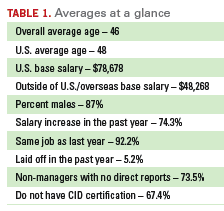
Education versus Experience
One question often asked by designers is what type of education is
needed to help you be more successful and achieve higher rewards as a
designer. It was interesting to look at the 2007 respondents based on
their educational background, the types of educational programs they
continued to be involved in and their actual salaries to get an idea of
what is really important.
Like nature and nurture, experience and education are the critical
foils of successful development in any profession. It was interesting
to see how these two factors affected the salary achievements in our
respondents.
According to the survey, designers with five or less years experience
in North America earned the lowest average salary, coming in at just
under $40,000. It was interesting to note that with six to 10 years
experience, the average salaries jumped to $68,000 equivalent to a 72%
increase. This seems to indicate that there is a minimum
time-on-the-job milestone on the road to success.
As reflected in
Figure 1, years of experience do influence a designer’s
salary, but over time, the rate of increase drops dramatically, so that
the difference in the average salary of a designer with over 30 years
of experience and that of a designer with 25 to 30 years of experience
is minimal.
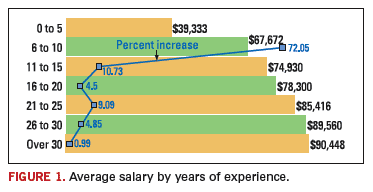
What about education? The results of the survey were actually very
interesting in this regard. Only 23.4% of the respondents indicated
that they had a bachelor’s, master’s or Ph.D. degree. The majority of
designers had either a high school education or had some college
without completing a degree; or they had earned a one-or two-year
associate’s degree. As reflected in
Figure 2, the difference between
getting a bachelor’s degree in anything other than a BSEE and a high
school only education was not a significant factor in the resulting
salary.
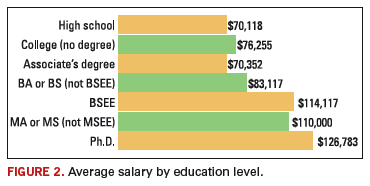
The average salary for a designer who learned on the job with only a
high school background was about $70,000 per year. With an associate’s
degree, the salary was still at $70,000. A designer with some college
working toward a BA/BS degree earned slightly more at $76,000 average.
The BSEE-degreed designer, however, sees a significant increase in
earnings with an average salary of over $125,000, and a Ph.D. holder
can also anticipate earning a six-figure salary.
Higher Salaries for Higher-Tech Designs
It was interesting to note that there didn’t appear to be a significant
difference between the types of designs being worked on or the number
of projects per year as far as salary goes. Designers working on one to
30 design projects per year earned on average $70,000 to $80,000 per
year. Those working on 31 to 50 projects per year had a jump to over
$100,000 per year on average, but working more than 50 projects per
year resulted in a decrease in average salary back to the $70,000 range
(
Figure 3).
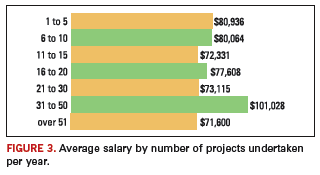
Likewise, it seemed that it didn’t mater if you were designing single
and double-sided boards, or multilayers. The difference in salary was
not significant. The average salaries were on track with the overall
average of $78,678. A difference was noted for those designers who
indicated that they only worked exclusively on boards that were over
seven layers or some specialty products such as BGAs, MCMs and
packaging designs. Their average salaries were closer to the $100,000
mark. (
Figure 4).
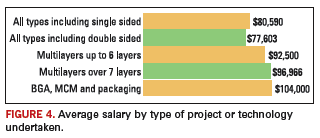
Strong OEM and Military Involvement
The designers who responded were from a wide variety of companies.
Tracking with our readership demographics, 64.3% (
Figure 5) work for
OEM companies. The next largest group works for design service bureaus
at 12.2%. The markets served by the designers represent a product mix
with a higher than expected level of military/government/avionics
companies at 20%, as seen in
Figure 6, compared to a typical market mix
that would have the segment at 5% to 6%.
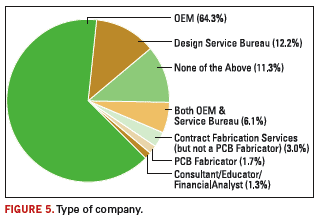

Forty percent of the designers who responded worked for either very
large companies with over 3,001 employees (20.4%) or very small
companies with 1 to 50 employees (19.6%) as shown in
Figure 7.
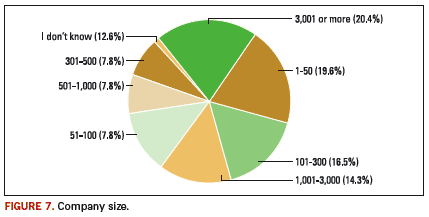
Job Satisfaction Factor
One of the key measurements for job satisfaction is overall
satisfaction with the career decision and one’s current position. In
the case of this year’s respondents, they were generally very satisfied
with their jobs. In fact, a whopping 89.1% of the respondents where
either very satisfied or satisfied with their career choice as
reflected in
Figure 8. That is a significant approval rating. And 72.1%
(
Figure 9) were satisfied or very satisfied with the current position.
The stability in the profession is further reflected in Table 1 where
92.2% of the respondents had the same position as they held last year.


It is somewhat of a concern that we are facing what appears to be an
aging designer population with apparently little influx in young design
talent. This is, in fact, quite disconcerting to many industry
professionals. In light of the fact that the profession pays well and
offers excellent opportunities for advancement for designers and
engineers regardless of their educational background, it would seem
that there would be a steady stream of young, hopeful design
apprentices moving into the ranks and up the salary ladder.
The only reason I can think of that this is not occurring is that
electrical engineering and the electronic design process are two of the
best-kept secrets with regards to actual job function and potential
benefit. In a recent job satisfaction survey conducted by
EE Times, it
was reported that over 70% of engineers still recommend engineering to
children as a career. It’s time that message reached a larger audience.
In addition to salary, standard holiday and vacation time, the survey
asked designers about additional perks and incentives offered by their
companies. The benefits included, as anticipated, health and dental
insurance, both available to over 75% of the respondents (
Figure 10),
as well as profit sharing and a gym/exercise room with both available
to about 30% of the designers and child care available to about 3% of
respondents.

Education, as mentioned before in terms of specific college degrees may
not be the leading indicator of how well a designer is compensated, but
experience and on-the-job training seem to be key factors. The good
news is that companies recognize the requirement for experiential
learning for their designers. As reflected in
Figure 11, over 60% of
designers indicated that their companies supported their attendance at
technical conferences to attend classes that offer design-specific
training. This is an essential component in the development of a
designer regardless of his or her academic background.
Conclusions
The 2007 design salary survey reflects a stable but aging population.
With an average age of 46 globally and 48 in North America, designers
aren’t ready quite yet for retirement, but without a steady influx of
new blood, it won’t be too many years before the numbers begin to
dwindle as older members begin to retire at a steady pace.
Recently, AOL ran an article on the top jobs in the U.S. based on a
salary and education matrix. The types of jobs listed ranged from
non-degreed jobs that paid $10 per hour to six-year degree jobs that
paid $30 per hour. In reviewing the over 30 positions represented, I
did not find a mention of electrical engineer, PCB designer or PCB
layout engineer.
For the 56.5% of you who responded that your company offers a tuition
reimbursement program, you might want to consider going after that
BSEE. It appears to be a short cut to a significant salary jump. If
more schooling is not for you, that’s okay, too. Just keep enriching
your experiences with company-sponsored classes, technical conference
attendance and on-the-job training because it looks like education is a
key factor in recognition, salary and overall achievement in PCB
design.
PCD&FKathy Nargi-Toth is editor of Printed Circuit Design & Fab; knargitoth [at] upmediagroup.com.
























